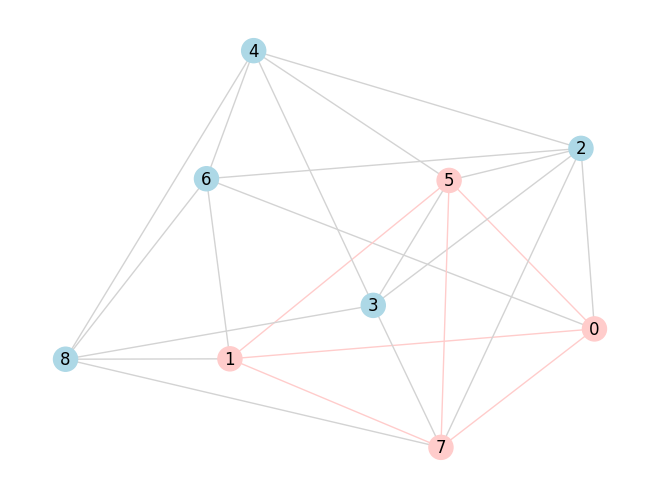QAOA MaxClique#
Problem description#
Given a Graph \(G = (V,E)\) find a maximum clique, i.e., a subset of vertices \(V' \subset V\) such that all pairs of vertices are adjacent in the graph \(G\). Following the work of Hadfield et al., the MaxClique problem is solved by solving the MaxIndepSet problem on the complement graph.
Classical cost function#
- create_max_clique_cl_cost_function(G)[source]#
Creates the classical cost function for an instance of the maximum clique problem for a given graph
G.- Parameters:
- Gnx.Graph
The Graph for the problem instance.
- Returns:
- cl_cost_functionfunction
The classical cost function for the problem instance, which takes a dictionary of measurement results as input.
MaxClique problem#
- max_clique_problem(G)[source]#
Creates a QAOA problem instance with appropriate phase separator, mixer, and classical cost function.
- Parameters:
- Gnx.Graph
The graph for the problem instance.
- Returns:
- QAOAProblem
A QAOA problem instance for MaxClique for a given graph
G.
Example implementation#
from qrisp import QuantumVariable
from qrisp.qaoa import QAOAProblem, RZ_mixer, create_max_indep_set_cl_cost_function, create_max_indep_set_mixer, max_indep_set_init_function
import networkx as nx
G = nx.erdos_renyi_graph(9, 0.7, seed = 133)
G_complement = nx.complement(G)
qarg = QuantumVariable(G.number_of_nodes())
qaoa_max_clique = QAOAProblem(cost_operator=RZ_mixer,
mixer=create_max_indep_set_mixer(G_complement),
cl_cost_function=create_max_indep_set_cl_cost_function(G_complement),
init_function=max_indep_set_init_function)
results = qaoa_max_clique.run(qarg, depth=5)
That’s it! In the following, we print the 5 most likely solutions together with their cost values.
cl_cost = create_max_indep_set_cl_cost_function(G_complement)
print("5 most likely solutions")
max_five = sorted(results.items(), key=lambda item: item[1], reverse=True)[:5]
for res, prob in max_five:
print([index for index, value in enumerate(res) if value == '1'], prob, cl_cost({res : 1}))
Finally, we visualize the most likely solution.
most_likely = [index for index, value in enumerate(max_five[0][0]) if value == '1']
nx.draw(G, with_labels = True, font_color='white', node_size=1000, font_size=22,
node_color=['#6929C4' if node in most_likely else '#20306f' for node in G.nodes()],
edge_color=['#6929C4' if edge[0] in most_likely and edge[1] in most_likely else '#D3D3D3' for edge in G.edges()])

